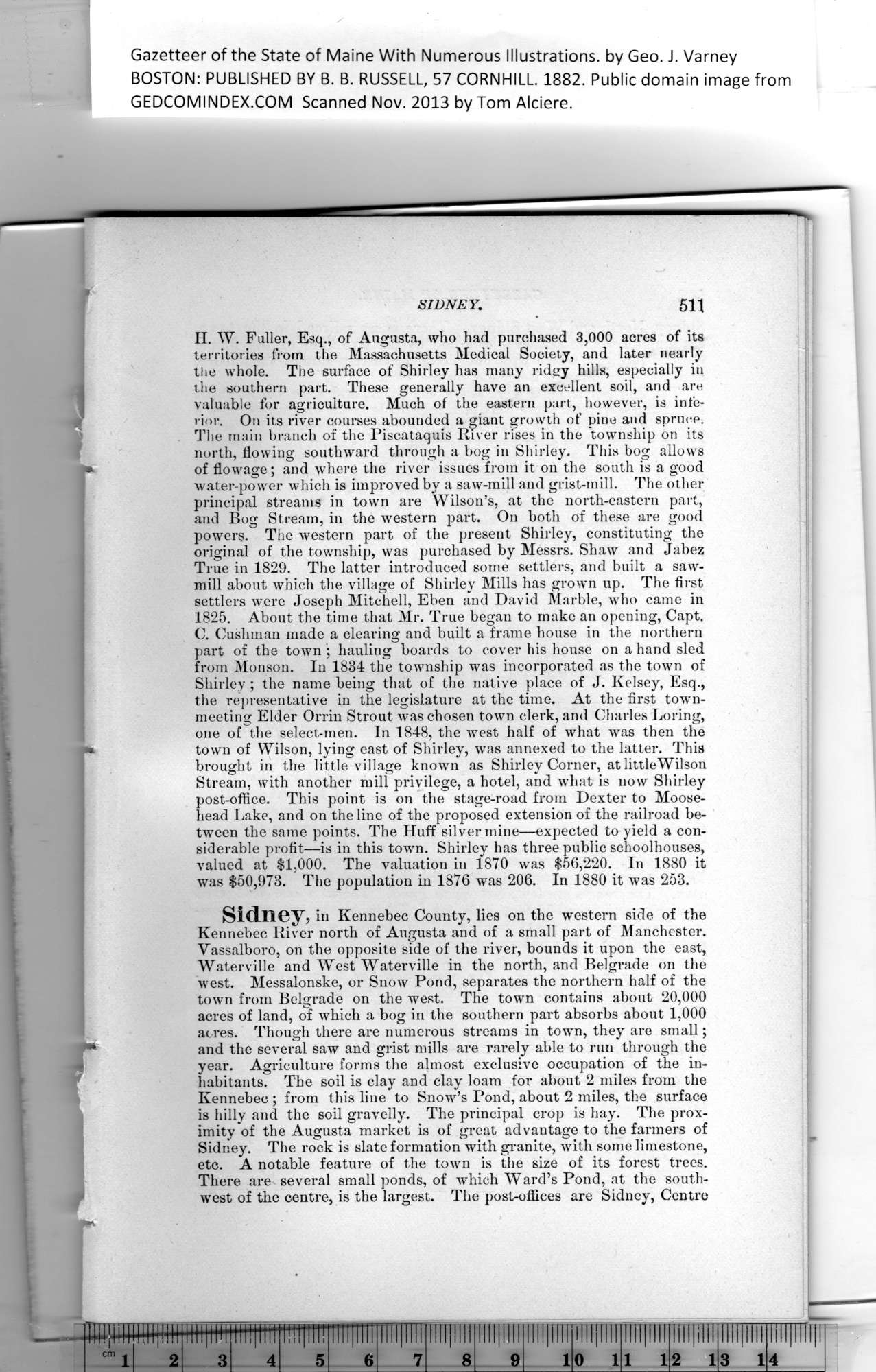|
Gazetteer of the State of Maine With Numerous Illustrations, by Geo. J. Varney
BOSTON: PUBLISHED BY B. B. RUSSELL, 57 CORNHILL. 1882. Public domain image from
SIDNEY. 511
H. W. Fuller, Esq., of Augusta, who had purchased 3,000 acres of its
territories from the Massachusetts Medical Society, and later nearly
the whole. The surface of Shirley has many ridgy hills, especially in
the southern part. These generally have an excellent soil, and are
valuable for agriculture. Much of the eastern part, however, is infe-
rior. On its river courses abounded a giant growth of pine and spruee.
The main branch of the Piscataquis River rises in the township on its
north, flowing southward through a bog in Shirley. This bog allows
of flowage; and where the river issues from it on the south is a good
water-power which is improved by a saw-mill and grist-mill. The other
principal streams in town are Wilson’s, at the north-eastern part,
and Bog Stream, in the western part. On both of these are good
powers. The western part of the present Shirley, constituting the
original of the township, was purchased by Messrs. Shaw and Jabez
True in 1829. The latter introduced some settlers, and built a saw-
mill about which the village of Shirley Mills has grown up. The first
settlers were Joseph Mitchell, Eben and David Marble, who came in
1825. About the time that Mr. True began to make an opening, Capt.
C. Cushman made a clearing and built a frame house in the northern
part of the town ; hauling boards to cover his house on a hand sled
from Monson. In 1834 the township was incorporated as the town of
Shirley ; the name being that of the native place of J. Kelsey, Esq.,
the representative in the legislature at the time. At the first town-
meeting Elder Orrin Strout was chosen town clerk, and Charles Loring,
one of the select-men. In 1848, the west half of what was then the
town of Wilson, lying east of Shirley, was annexed to the latter. This
brought in the little village known as Shirley Corner, atlittleWilson
Stream, with another mill privilege, a hotel, and what is now Shirley
post-office. This point is on the stage-road from Dexter to Moose-
head Lake, and on the line of the proposed extension of the railroad be-
tween the same points. The Huff silver mine—expected to yield a con-
siderable profit—is in this town. Shirley has three public schoolhouses,
valued at $1,000. The valuation in 1870 was $56,220. In 1880 it
was $50,973. The population in 1876 was 206. In 1880 it was 253.
Sidney, in Kennebec County, lies on the western side of the
Kennebec River north of Augusta and of a small part of Manchester.
Vassalboro, on tbe opposite side of the river, bounds it upon the east,
Waterville and West Waterville in the north, and Belgrade on the
west. Messalonske, or Snow Pond, separates the northern half of the
town from Belgrade on the west. The town contains about 20,000
acres of land, of which a bog in the southern part absorbs about 1,000
acres. Though there are numerous streams in town, they are small;
and the several saw and grist mills are rarely able to run through the
year. Agriculture forms the almost exclusive occupation of the in-
habitants. The soil is clay and clay loam for about 2 miles from the
Kennebec ; from this line to Snow’s Pond, about 2 miles, the surface
is hilly and the soil gravelly. The principal crop is hay. The prox-
imity of the Augusta market is of great advantage to the farmers of
Sidney. The rock is slate formation with granite, with some limestone,
etc. A notable feature of the town is the size of its forest trees.
There are several small ponds, of which Ward’s Pond, at the south-
west of the centre, is the largest. The post-offices are Sidney, Centre
PREVIOUS PAGE ... NEXT PAGE
This page was written in HTML using a program written in Python 3.2
|
